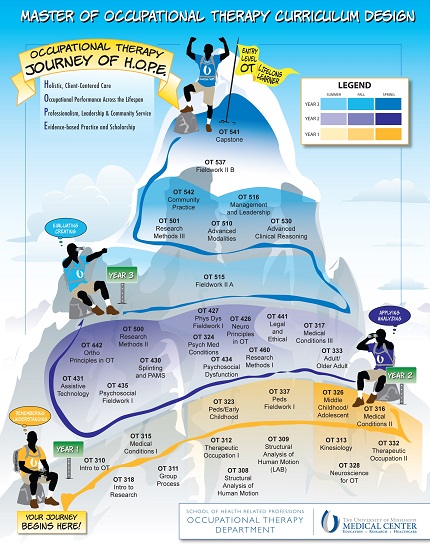- SHRP
- Programs
- Master Programs
- Master of Occupational Therapy
- MOT Curriculum
MOT Curriculum
Curriculum Design
Notably, these four guiding threads provide a fitting acronym of HOPE which has been adopted by our program as a unique method to express the overarching principle for occupational therapy and occupational therapy education. These threads are evident when reviewing curriculum design elements such as course titles/descriptions, objectives, and assignments throughout the program.
 In the illustration to the right, our curriculum design is expressed through the metaphor of a mountain climbing journey. It is believed this graphic communicates the active and rewarding, yet rigorous, student experience of our Master of Occupational Therapy Program. Not only does the illustration capture our guiding curricular threads, but it also previews the scope of the program through identifying the course sequence, course names, learning level expectations, and the general interactive nature of the program.
In the illustration to the right, our curriculum design is expressed through the metaphor of a mountain climbing journey. It is believed this graphic communicates the active and rewarding, yet rigorous, student experience of our Master of Occupational Therapy Program. Not only does the illustration capture our guiding curricular threads, but it also previews the scope of the program through identifying the course sequence, course names, learning level expectations, and the general interactive nature of the program.
More specifically, the curriculum sequence is influenced by the developmental nature of human beings and the function – dysfunction continuum. For the developmental design aspect of the curriculum, the natural lifespan is followed by introducing content sequentially as seen in the typical human growth and development process. Additionally, the curriculum introduces information to student learners on a continuum from normal to pathological (i.e., function to dysfunction). Foundational components of normal function are embedded either as prerequisites or early in the curriculum (e.g., human growth and development, anatomy, neurology, kinesiology, psychology, and group process). Subsequently, content related to dysfunction is integrated at key points throughout the curriculum as a contrast to normal function. In addition to an emphasis on the function to dysfunction continuum for the individual, the inclusion of similar information related to groups, communities, and populations is integrated within the curriculum.
The instructional plan for the curriculum embraces the revised version of Bloom’s Taxonomy. The progression of content delivery and assessment methods are structured from the simple to complex through didactic to real world application opportunities. We include a primary emphasis each year on progressive learning levels in Bloom’s Taxonomy (i.e., year one emphasis: remembering / understanding, year two emphasis: applying / analyzing; year three emphasis: evaluating / creating). However, as proposed by Cannon and Feinstein in their writing Bloom beyond Bloom, we concur that “the various levels are allowed to be overlapping, rather than forcing them to be a rigorous hierarchy”, and as a result, our curriculum allows a flexible interaction and blending among the levels of learning in order to meet the learning needs of students at any given time.
The MOT program’s student learning outcomes are closely connected to the four primary curriculum threads integrated throughout the three years of study. In addition, the learning outcomes were deliberately crafted to complement our overall program goals and program evaluation strategies which inform programmatic changes.
| Curriculum Thread | Graduates of UMMC's School of Health Related Professions Department of Occupational Therapy Program shall: |
| Thread I: Holistic client centered care, including psychosocial aspects |
|
| THREAD II: Occupational performance across the lifespan, infancy to end of life |
|
| THREAD III: Professionalism, leadership and community service |
|
| Thread IV: Evidence-based practice and scholarship |
|


